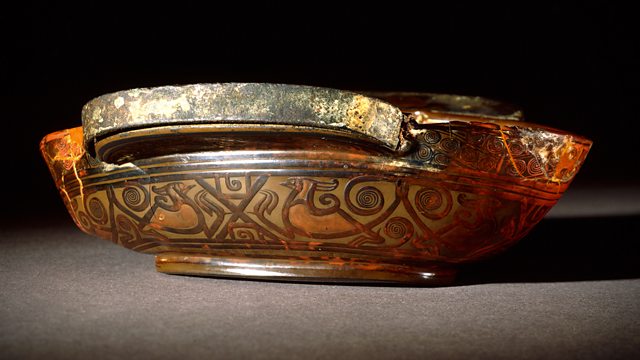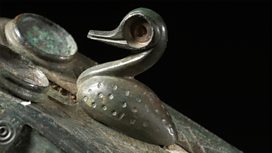Chinese Han lacquer cup
The history of the world as told through objects at the British Museum. Today, the imperial ambitions of Han Dynasty China as described through a beautiful lacquer cup
In a week of programmes exploring the nature of power and the emergence of new rulers around the world 2000 years ago, Neil MacGregor takes us to Han Dynasty China. He tells the story of how the Chinese maintained loyalty and control by dispensing luxury gifts. He describes the world of the imperial Han through an exquisite lacquer wine cup that was probably given by the emperor to one of his military commanders in North Korea. The historian Roel Sterckx underlines the importance of lacquer for the period while writer Isabel Hilton looks at how the production of goods under state control has remained a consistent interest of the Chinese.
Producer: Anthony Denselow
Last on
![]()
Discover more programmes from A History of the World in 100 Objects about food and farming
About this object
Location: China
Culture: Ancient and Imperial China
Period: AD 4
Material: Gold and Lacquer
��
Lacquer cups, like this one, were sometimes given by the emperor to an official as a gift or in lieu of salary. An inscription on the bottom lists the six artisans that made the cup and the seven product inspectors who guaranteed its quality. Lacquer objects were expensive, this cup is said to be worth 10 bronze cups. Lacquer objects were valued because they were time consuming to create. Lacquer is obtained from tree sap and a cup may require over six coats.
Who were the Han Dynasty?
China rivalled the Roman Empire in terms of wealth and size under the reign of the Han dynasty (221 BC ? AD 220). The Han established a central government and an efficient civil service. Applicants were tested on their knowledge of the teachings of Confucius. The state strictly controlled prices and merchants were not allowed to own land, become officials or even wear silk. However, the Silk Road allowed Chinese merchants to trade silk and other products as far as the Roman Empire.
Did you know?
- Lacquer was thought by the Han to have magical qualities as an elixir of immortality.
Layering perfection
By Caroline Cartwright, scientist, British Museum
��
The lacquer used on Chinese, Korean and Japanese objects is the sap of the ‘lacquer tree’, Rhus verniciflua, also known as Toxicodendron vernicifluum. This species belongs to the Anacardiaceae family which contains many useful trees including those used for food such as pistachio, mango and cashew.
The sap of the lacquer tree is very toxic and caustic. It can cause severe blistering of the skin and allergic reactions as well as breathing problems. Nevertheless these trees were cultivated specifically for producing this durable coating, lacquer.
Sap is tapped by slashing the trunk of a tree horizontally up to 10 times. When first collected the sap is a creamy or greyish yellow colour but it changes to a brownish black on exposure to light. Before the lacquer can be used it needs to be filtered and heat-treated.
Creating a lacquer object, such as the Chinese Han cup, is a very painstaking and time-consuming process with many thin layers of lacquer being applied with special tools to a wooden core. On occasion as many as 300 coats may be applied and each layer must dry and be polished before the next one can be applied. As lacquer hardens very slowly this may mean that only one layer can be put on in a day.
Specialist craftsmen used cypress wood spatulas and brushes of human hair to apply the layers of lacquer. Fine rat or mouse-hair brushes were used for the detailed fine lines of gold design and many other different forms of decoration were used by lacquerers such as silk patterns, sharkskin texture and silver or gold dusting.
Lacquered objects are usually polished to a very high gloss and are extremely durable. A variety of materials can be used to colour it. For example, traditional red and black lacquer was often made by adding the mineral cinnabar for the red colour and carbon or iron oxide for the black colour.
The richness of the colour, the extraordinary craftsmanship involved and the fact that raw lacquer is so toxic and difficult to use means that lacquer wares became luxury items treasured by the upper class.
The new industrial revolution
By Isabel Hilton, journalist and broadcaster
��
Forty years ago, 60% of the Chinese population, which is one fifth of the world’s population, was engaged in agriculture and one of the main Chinese exports was pig bristle in an economy that was smaller than that of Belgium. Fast forward to today and 60% of the population are working in industry. China has overtaken Germany as one of the world’s major exporters and it’s the biggest manufacturer of almost everything; all the objects of everyday use, particularly those high volume, low value added, high turnover objects.
But increasingly China is moving up the value chain to higher grade technologies and recovering in a sense that position of pre-eminence it held in the Han dynasty and through much of its history as a technology innovator. We see China now reconnecting this enormous industrial revolution, the biggest, fastest, most overwhelming industrial revolution the world has ever seen is reconnecting to a tradition of Chinese technological innovation, moving onto another phase.
Transcript
Broadcasts
- Thu 20 May 2010 09:45���˿��� Radio 4 FM
- Thu 20 May 2010 19:45���˿��� Radio 4
- Fri 21 May 2010 00:30���˿��� Radio 4
- Thu 3 Dec 2020 13:45���˿��� Radio 4
Featured in...
![]()
Food and Farming—A History of the World in 100 Objects
A History of the World in 100 objects - Food and farming
Podcast
-
![]()
A History of the World in 100 Objects
Director of the British Museum, Neil MacGregor, retells humanity's history through objects





